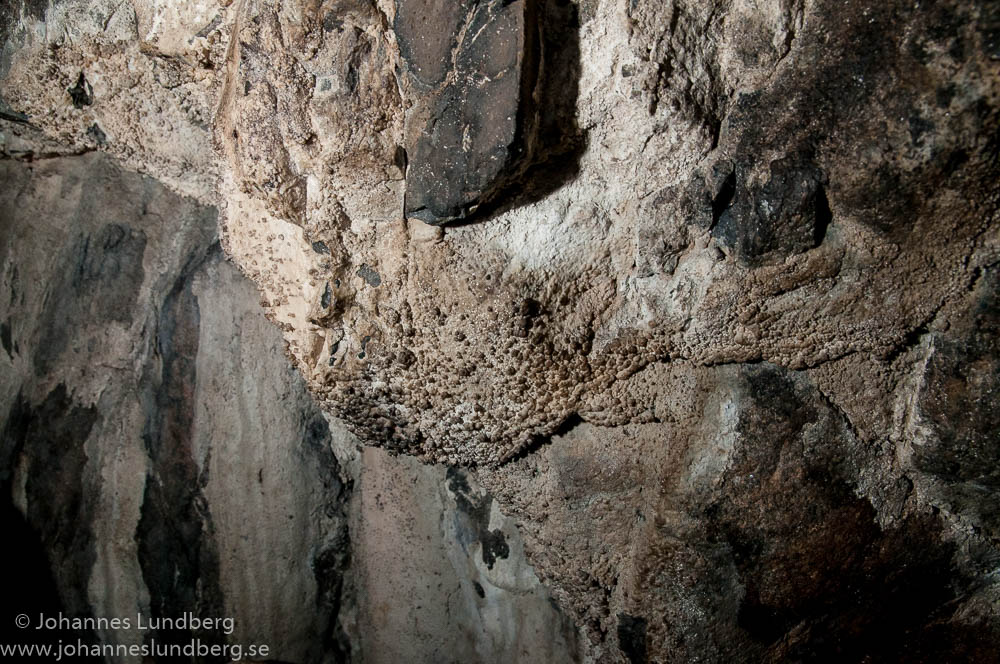How Cave Slime Helps Create Dripstones

Before popcorn ceilings ever became an interior design cliché, cave-dwelling bacteria were decorating their dark roofs with knobby crusts of rock.
In an 8,000-year-old cave in northern Sweden, lumpy clusters of rock called cave popcorn adorn the ceiling. Slick, slightly slimy biofilms, or layers of bacteria, also coat large swaths of the cave. Researchers who squeezed into the cave in 2011 have discovered that the microbes are more than just tenants. In this cave, the bacteria are master builders.
"Without the microbial presence, the speleothems would be much smaller or perhaps absent," said study co-author Magnus Ivarsson, a researcher at the University of Southern Denmark's Nordic Center for Earth Evolution. [Images: See the Cave Where Bacteria Build Rocks]
Speleothem is a catchall term for stalactites, stalagmites or any of the fanciful dripstone structures created by mineral-laden water seeping inside a cave.
Dripstones serve as homes to many different microorganisms, including bacteria, fungi, algae and even mites. But whether the microscopic life constructs rock, or simply gets caught up in the process, is not fully understood, Ivarsson said.
However, Sweden's Tjuv-Antes cave provides crystal-clear evidence for bacterial masonry, Ivarsson and his co-authors report in the September 2014 issue of the International Journal of Speleology. In fact, without the bacteria, the crystalline calcite formations might not even exist, Ivarsson said.
Tjuv-Antes cave is carved from granite, but the dripstones form only on a vein of dolerite rock (similar in composition to basalt) that cuts through the cleft. Along the dolerite vein, coral-like fingers of calcite dangle from the cave ceiling, and smooth sheets of flowstone dribble down the walls. Nubby popcorn adds texture to the roof. The deposits are up to 1,250 years old.
Sign up for the Live Science daily newsletter now
Get the world’s most fascinating discoveries delivered straight to your inbox.
The biofilm bacteria also fancy the dolerite rock, growing only on the vein and avoiding granite. The biofilm is tucked into the dolerite's cracks and crevices, where water seeps in. The living biofilm bacteria are Actinobacteria, a microbe that favors dark, musty spaces like caves and underground rail stations. Some strains of the bacteria also secrete calcite, such as in Spain's Altamira cave, famous for its prized prehistoric paintings of ancient European mammals.
When Ivarsson and his colleagues toted samples of the biofilm and dripstones back to a lab, they discovered a surprising connection between the rocks and bacteria. First, the dripstone rocks revealed distinct layers of light and dark growth. The thicker layers of lighter rock were mostly calcite, and the thinner, darker layers contained a mix of opal, carbon and fossilized bacteria. The alternating light and dark layers represent seasonal growth spurts, when water dripping into the cave in spring and summer spurs intense bacterial activity, the researchers determined.
Second, the living biofilms were producing calcium, the dripstone's key building block. "As the microbes metabolized, they excreted calcium which precipitated and in time helped form the dripstones," Ivarsson said.
The researchers said they suspect other microbes also live in the cave, and the scientists are now analyzing genetic data from the samples to better understand the cave ecosystem. For instance, a fungus feeds on the bacterial colonies, producing an acid that dissolved the calcite.
Ivarsson said similar environments on other planets could potentially shelter rock-loving life. "On Mars, there are a lot of lava tunnels similar in composition to the dolerite in our cave," he said. "If I were a microbe, I would definitely live in a cave on Mars."
Email Becky Oskin or follow her @beckyoskin. Follow us @livescience, Facebook & Google+. Original article on Live Science.











